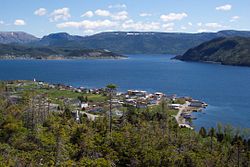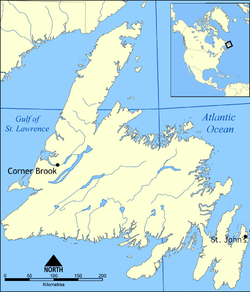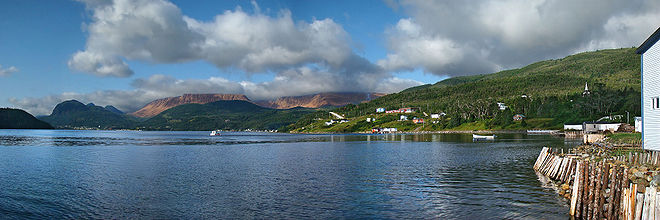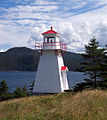- Woody Point, Newfoundland and Labrador
-
Woody Point — Town — Woody Point from lookout Location of Woody Point in Newfoundland Coordinates: 49°30′N 57°56′W / 49.5°N 57.933°W Country  Canada
CanadaProvince  Newfoundland and Labrador
Newfoundland and LabradorSettled 1849 Incorporated 1956 Area – Total 2.91 km2 (1.1 sq mi) Elevation 25 m (82 ft) Population (2006) – Total 355 – Density 121.8/km2 (315.5/sq mi) Time zone Newfoundland Time (UTC-3:30) – Summer (DST) Newfoundland Daylight (UTC-2:30) Postal code span A0K Area code(s) 709 Woody Point is a town located in the heart of Gros Morne National Park, on the western coast of Newfoundland. Situated on Bonne Bay, the Town of Woody Point encompasses three areas, Curzon, Woody Point and Winterhouse Brook. It has a total population of 355[1] residents. Woody Point has a waterfront with many heritage buildings and four Registered Newfoundland and Labrador Heritage Structures. The community is served by Route 431.
Contents
History
French Shore
Europeans were slow to settle the west coast of Newfoundland. The British were concentrated on the east coast, and the French were on the Grand Banks. The 1713 Treaty of Utrecht gave the French some area on the west coast which was extended in 1783 to the entire coast.
British settlement was spreading, as well. In 1800 the first British settlement in the Bonne Bay area occurred in Woody Point with the establishment of the firm of Joseph Bird from Sturminster Newton. He had an agent and premises to serve the British fishing interests which were principally migratory at this point. When fishermen began to stay during the winter rather than return to England, the pattern for permanent settlement was laid.
By 1904, the French had left the area to pursue fisheries farther up the coast. By this time, Woody Point was bustling. It was considered the capital of the area with banking and customs offices, merchants, and a harbour full of domestic and foreign vessels.
First settlers
John Roberts and his wife, Emma, together with their four children are considered to be the first settlers of Woody Point. They came in 1849. By 1872, there were 129 families residing in the Bonne Bay area.
In 1873, the Bonne Bay Post Office was established in the home of J.R. Roberts, John Roberts' nephew. This house was one of the first built in the area and is still standing today. It is a blue clapboarded structure on the Shore Road left of the downtown. Plans are being made to restore this house.
Solomon Wilton was the second settler to Woody Point. It was Wilton who donated the land on which the present day Church of the Epiphany was built. A school and parsonage once stood on this sport. These early founding families are laid to rest in the Anglican cemetery on Shore Road.
Major events
In 1922, when Woody Point was experiencing the height of its population and commercial success, a devastating fire ripped through the downtown. The wind quickly carried the flames which shot all the way across the Bay to Norris Point. In all, 58 buildings were destroyed. The degree of commerce in the town never returned to the pre-fire level.
Most of the buildings currently on the waterfront date from after 1922, but there are some exceptions. The lighthouse was built in 1919. Also, the large grey and green house to the right of the Lighthouse Restaurant was built in the 1890s. This house was the scene of a riot in 1938.
Unable to bear the hardships of the Depression and the 6¢ a day dole ration, the residents demanded a meeting with Commissioner Wood. He came ashore long enough to say "no" to the demands and tried to get back aboard the M/V Shulamite. Six men had gotten aboard to try and keep the vessel docked, but the Captain put full speed astern and broke the lines. The men were taken to Corner Brook for the night, whilst Sir Wood was barricaded in this house, which served as the courthouse in those times, for his own protection. The next day the men were returned and Sir Wilfred left for Corner Brook.
Climate
Climate data for Woody Point Month Jan Feb Mar Apr May Jun Jul Aug Sep Oct Nov Dec Year Record high °C (°F) 15
(59)12.8
(55.0)16.5
(61.7)22.5
(72.5)25
(77)27
(81)29.5
(85.1)30.6
(87.1)27
(81)22
(72)18.5
(65.3)16.1
(61.0)30.6
(87)Average high °C (°F) −3.5
(25.7)−4.4
(24.1)0
(32)5.4
(41.7)10.9
(51.6)16.2
(61.2)20.2
(68.4)19.9
(67.8)15.6
(60.1)9.6
(49.3)4.4
(39.9)−0.7
(30.7)7.8 Average low °C (°F) −10.7
(12.7)−12.6
(9.3)−8.6
(16.5)−1.8
(28.8)2.6
(36.7)7.6
(45.7)11.9
(53.4)12.1
(53.8)8.3
(46.9)3.3
(37.9)−1.1
(30.0)−7
(19)0.3 Record low °C (°F) −25
(−13)−31
(−24)−31
(−24)−18
(0)−7.2
(19.0)−1
(30)2.8
(37.0)2.8
(37.0)−1.7
(28.9)−6.7
(19.9)−13
(9)−22.5
(−8.5)−31
(−24)Precipitation mm (inches) 230.9
(9.091)128.3
(5.051)99.4
(3.913)68.6
(2.701)80.2
(3.157)113
(4.45)112
(4.41)124.9
(4.917)133.7
(5.264)163.2
(6.425)168.9
(6.65)197.6
(7.78)1,620.7
(63.807)Source: Environment Canada[2] Gallery
References
- ^ Population and dwelling counts
- ^ Environment Canada Canadian Climate Normals 1971–2000, accessed 15 July 2009
External links
Coordinates: 49°30′N 57°56′W / 49.5°N 57.933°W
 Subdivisions of Newfoundland and Labrador
Subdivisions of Newfoundland and LabradorCensus divisions Cities Other communities Bishop's Falls · Bonavista · Botwood · Carbonear · Channel – Port aux Basques · Clarenville · Conception Bay South · Deer Lake · Ferryland · Fogo · Gander · Grand Bank · Grand Falls-Windsor · Happy Valley – Goose Bay · Harbour Grace · Hopedale · Labrador City · Marystown · Nain · Norris Arm · Pasadena · Peterview · Placentia · Red Bay · St. Anthony · Stephenville · Twillingate · Torbay · Woody Point · Makkovik Category:Newfoundland and Labrador ·
Category:Newfoundland and Labrador ·  Portal:Newfoundland and Labrador ·
Portal:Newfoundland and Labrador ·  WikiProject:Newfoundland and LabradorCategories:
WikiProject:Newfoundland and LabradorCategories:- Towns in Newfoundland and Labrador
Wikimedia Foundation. 2010.















